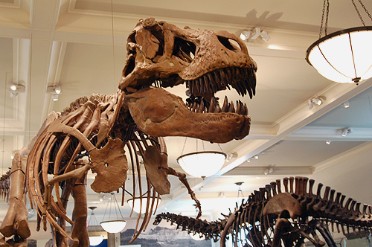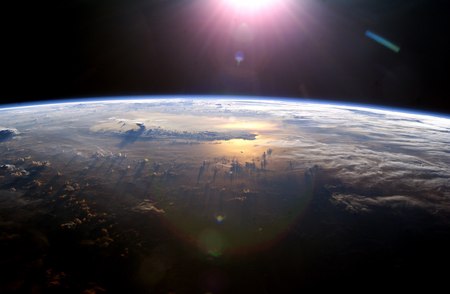------------------------------------------------------------------------------------------------
DINOSAURS
 | Dinosaurs are a diverse group of reptiles. They were the dominant terrestrial vertebrates for over 160 million years, from the late Triassic period (about 230 million years ago) until the end of the Cretaceous period (about 65 million years ago), when the Cretaceous–Tertiary extinction event caused the extinction of most dinosaur species, except for some birds. The fossil record indicates that birds evolved from theropod dinosaurs during the Jurassic period, and most paleontologists regard them as the only group of dinosaurs to have survived until the present day.[1]
Dinosaurs are a diverse and varied group of animals; birds, at over 9,000 species, are the most diverse group of vertebrate besides perciform fish.[2] Paleontologists have identified over 500 distinct genera[3] and more than 1,000 different species of non-avian dinosaurs.[4] Dinosaurs are represented on every continent by both extant species and fossil remains.[5] Some dinosaurs are or were herbivorous, others carnivorous. Some have been bipedal, others quadrupedal, and others have been able to shift between these body postures. Many non-avian species developed elaborate skeletal modifications such as bony armor, horns or crests. Avian dinosaurs have been the planet's dominant flying vertebrate since the extinction of the pterosaurs. Although generally known for the large size of some species, most dinosaurs were human-sized or even smaller. Most groups of dinosaurs are known to have built nests and laid eggs.
The term "dinosaur" was coined in 1842 by the English paleontologist Richard Owen, and derives from Greek δεινός (deinos) "terrible, powerful, wondrous" + σαῦρος (sauros) "lizard". Through the first half of the twentieth century, most of the scientific community believed dinosaurs to have been sluggish, unintelligent cold-blooded animals. Most research conducted since the 1970s, however, has indicated that dinosaurs were active animals with elevated metabolisms and numerous adaptations for social interaction.
Since the first dinosaur fossils were recognized in the early nineteenth century, mounted dinosaur skeletons have been major attractions at museums around the world, and dinosaurs have become a part of world culture. They have been featured in best-selling books and films such as Jurassic Park, and new discoveries are regularly covered by the media. The outdated image of dinosaurs as maladapted extinct monsters has led to the word "dinosaur" entering the vernacular to describe anything that is impractically large, slow-moving, obsolete, or bound for extinction |
------------------------------------------------------------------------------------------------
SPACE
This article is about the general framework of distance and direction. For the space beyond Earth's atmosphere, see Outer space. For all other uses, see Space (disambiguation).
Space is the boundless, three-dimensional extent in which objects and events occur and have relative position and direction.[1] Physical space is often conceived in three linear dimensions, although modern physicists usually consider it, with time, to be part of the boundless four-dimensional continuum known as spacetime. In mathematics one examines 'spaces' with different numbers of dimensions and with different underlying structures. The concept of space is considered to be of fundamental importance to an understanding of the physical universe although disagreement continues between philosophers over whether it is itself an entity, a relationship between entities, or part of a conceptual framework.
Debates concerning the nature, essence and the mode of existence of space date back to antiquity; namely, to treatises like the Timaeus of Plato, in his reflections on what the Greeks called: chora / Khora (i.e. 'space'), or in the Physics of Aristotle (Book IV, Delta) in the definition of topos (i.e. place), or even in the later 'geometrical conception of place' as 'space qua extension' in the Discourse on Place (Qawl fi al-makan) of the 11th century Arab polymath Ibn al-Haytham (Alhazen).[2] Many of these classical philosophical questions were discussed in the Renaissance and then reformulated in the 17th century, particularly during the early development of classical mechanics. In Isaac Newton's view, space was absolute - in the sense that it existed permanently and independently of whether there were any matter in the space.[3] Other natural philosophers, notably Gottfried Leibniz, thought instead that space was a collection of relations between objects, given by their distance and direction from one another. In the 18th century, the philosopher and theologian George Berkely attempted to refute the 'visibility of spatial depth' in his Essay Towards a New Theory of Vision. Later, the great metaphysician Immanuel Kant described space and time as elements of a systematic framework that humans use to structure their experience; he referred to 'space' in his Critique of Pure Reason as being: a subjective 'pure a priori form of intuition', hence that its existence depends on our human faculties.
In the 19th and 20th centuries mathematicians began to examine non-Euclidean geometries, in which space can be said to be curved, rather than flat. According to Albert Einstein's theory of general relativity, space around gravitational fields deviates from Euclidean space.[4] Experimental tests of general relativity have confirmed that non-Euclidean space provides a better model for the shape of space. |  |
------------------------------------------------------------------------------------------------
ATMOSPHERE OF EARTH
 | The atmosphere of Earth is a layer of gases surrounding the planet Earth that is retained by Earth's gravity. The atmosphere protects life on Earth by absorbing ultraviolet solar radiation, warming the surface through heat retention (greenhouse effect), and reducing temperature extremes between day and night. Dry air contains roughly (by volume) 78.09% nitrogen, 20.95% oxygen, 0.93% argon, 0.039% carbon dioxide, and small amounts of other gases. Air also contains a variable amount of water vapor, on average around 1%.
The atmosphere has a mass of about 5 × 1018 kg, three quarters of which is within about 11 km (6.8 mi; 36,000 ft) of the surface. The atmosphere becomes thinner and thinner with increasing altitude, with no definite boundary between the atmosphere and outer space. An altitude of 120 km (75 mi) is where atmospheric effects become noticeable during atmospheric reentry of spacecraft. The Kármán line, at 100 km (62 mi), also is often regarded as the boundary between atmosphere and outer space. |